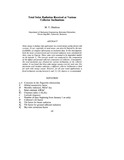| dc.contributor.author | Oladiran, M.T. | |
| dc.date.accessioned | 2011-02-09T13:59:14Z | |
| dc.date.available | 2011-02-09T13:59:14Z | |
| dc.date.issued | 1994 | |
| dc.identifier.citation | Oladiran, M.T. (1994) Total solar radiation received at various collector inclinations, Applied Energy, Vol. 48, No. 2, pp. 149-161 | en_US |
| dc.identifier.issn | 0306-2619 | |
| dc.identifier.uri | http://hdl.handle.net/10311/672 | |
| dc.description.abstract | Solar energy is finding wide application via several energy-saving devices and systems. Its use, especially in rural areas, can often be limited by the non-availability of complete information on insolation data. In this investigation, both the mean extraterrestrial and terrestrial radiations were calculated for three zones in Nigeria. These zones were assumed to be dependent mainly on the latitude, L. The isotropic model was employed for the computation of the diffuse and ground reflected components of radiation. Consequently, the total insolation was obtained for various inclinations of the collector surface. It was found that three solar energy seasons exist for each zone. For maximum total incident radiation, a different collector inclination is ideal for each solar energy season. However, for all year round applications, a fixed inclination varying between L and (L+10) degrees is recommended. | en_US |
| dc.language.iso | en | en_US |
| dc.publisher | Elsevier Science Ltd, http://www.elsevier.com/wps/find/journaldescription.cws_home/405891/description#description | en_US |
| dc.subject | Solar radiation | en_US |
| dc.subject | Solar energy | en_US |
| dc.subject | Collector inclinations | en_US |
| dc.subject | Nigeria | en_US |
| dc.title | Total solar radiation received at various collector inclinations | en_US |
| dc.type | Published Article | en_US |

